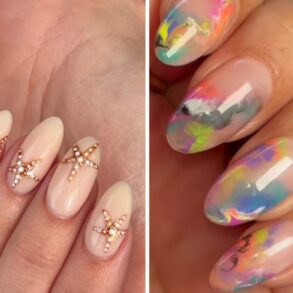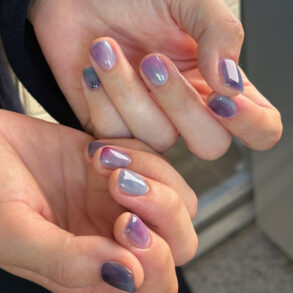If you’re the sort of person that enjoys switching up your manicure with every nail trend or nail art design that comes your way, you’ll know that the removal process isn’t always easy. So your fresh acrylic nails is now weeks old and visibly grown out and need removing ASAP, but you’re on a tight schedule with no time to go to the salon. Not ideal, but I’ve got you.
Removing acrylics at home doesn’t have to be terrifying nor ruin your nails, but there are things you need to know. First you’re going to need the right tools (don’t worry, I’ve listed them here for you), and then you’re going to need to follow the right method. This involves not getting tempted by TikTok’s hacks, which I’m sad to say are too good to be true. You’ll be left with bare nails that have been unharmed by the acrylics because you took your time with removal—go you!
Here’s how to safely remove your acrylic nails with as little damage as possible to your natural nails.
How to remove acrylics safely at home
You can’t remove acrylics without any tools, so there are a few things you’ll need before you get started. You’ll need a coarse grit nail file, pure acetone, nail clippers, cotton pads and tin foil (or a nail bowl) a cuticle pusher and cuticle oil. If you’re not sure what each item is for, don’t panic, I’ll be going through what it’s all for.

100/180 Grit Double Sided Nail File
You’ll need a fairly coarse nail file before going in with your acetone. If you find filing is taking you ages, you can go for an 80 grit file, which is coarser.

Sularpek Nail Cutter
You’ll need to clip down the excess of your acrylic tips, so you’ll need some extra strong clippers. I recommend getting artificial nail clippers like these ones.
Before we dive into how to remove them at home, I feel compelled to tell you that getting acrylics removed professionally is always the best, and safest, way to go. If you can, book into the salon. But I also understand that sometimes needs must and you need to take matters into your own hands.
The next thing you need to know is that removing your acrylics yourself at home will take you about an hour; it’s not a super quick process (but it’s worth it to maintain the health of your nails). Get on some good TV and pour yourself a drink.
Step 1: Clip off the excess
If your acrylics are really long, clip off the excess length using your artificial nail clippers. Be sure not to go too far down to the natural nail, but take off as much as you can.
Step 2: File off the shine
If you’ve got gels over the top of your acrylics, you’ll want to buff away the entire surface of the nail enhancement to take away that shiny surface. This helps break the seal before soaking in acetone.
You’ll need to use a 100/80 (or 100/180) grit file for this. This is coarser than your standard emery board and is necessary to remove that top shiny layer. This is not a file to use on your natural nails, so make sure to keep the two separate.
Step 3: Prepare your acetone wraps
Either you’ll be using the foil wraps already prepared or making your own. If you’re making your own, you’ll need cotton pads that you’ve cut in half and also some cut up some strips of tin foil (enough to wrap around each finger).
Take your acetone and saturate the cotton pad (I mean really saturate, don’t be stingy here), and then wrap your finger tight with the tin foil wrap making sure to fold over the tip so that no air can get into the wrap.
Do this to all of your nails and leave to soak for at least 30 minutes (you might need longer than this).
If you don’t want to faff with wrapping them, you can soak them in a bowl; you can buy specific nail soaking bowls for this.
Step 4: Carefully push off acrylic
Once your nails are soaked, you should be able to easily and gently flake off the acrylic; depending on the product used, the acrylic may be a little gooey as you remove it. You shouldn’t have to be scraping at all. If it’s not coming, do not pry it, simply rewrap the nails and repeat the process. This is where it can become a little bit tedious, but stick with it and try to be patient. It’s well worth the extra effort and few minutes to maintain the health of your nails.
Once the acrylic has been removed, you might want to use a very fine nail file to buff away the natural nail. Do this gently (and I mean gently, there is no need to apply a ton of pressure here) and with a 220/280 fine grit file.
Step 5: Cuticle oil
Finally, it’s a good idea to rehydrate the nails with cuticle oil. If you’re removing and painting your nails right away, wait to apply cuticle oil right at the end. But, if you’re leaving your nail bare then go for it with the oil application.
If you find that your nails get particularly dry during removal (due to the acetone), you can apply a little cuticle oil to your nails before wrapping them in your cute acetone parcels.
How NOT to remove your acrylic nails
Okay, there are a few things to clear up when it comes to what not to do when removing acrylics at home.
If someone tells you to remove your acrylics with dental floss, run a mile. This is a trend that promises quick and painless removal but will likely not work properly and only damage your nails. Please avoid doing this.
Do not use a nail drill at home if you have not had proper training. Not only can you ruin your nails doing this, but you can also run into issues if you haven’t got adequate equipment like enough ventilation in the room whilst using a drill. Getting a 100/80 grit nail file will do the job fine. It might take a few extra minutes but it’s a much safer way of doing it at home if you’re not trained.
Sadly, unlike TikTok would lead us to believe, you can’t use fairy liquid and oil to soak off your acrylics. This might work for acrylics that have already lifted but you’re going to do damage snapping these off, so I don’t recommend this method at all.
This post was originally published on this site be sure to check out more of their content.






